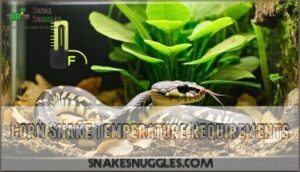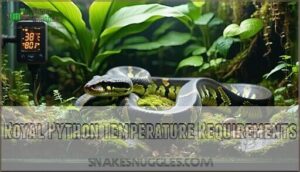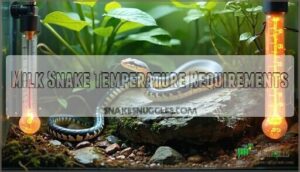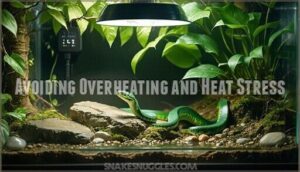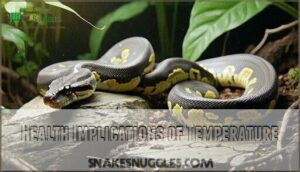This site is supported by our readers. We may earn a commission, at no cost to you, if you purchase through links.

You’ll need a thermal gradient with a warm basking spot between 85-95°F and a cooler area around 75-80°F.
Most species require nighttime drops of 5-10 degrees to match their natural rhythms.
Use quality thermostats with heating pads or ceramic emitters—never rely on guesswork.
Temperature affects everything from digestion to immune function, so investing in proper monitoring equipment isn’t optional.
Different species have unique needs that can make or break your setup success, and getting the temperature right is critical for their health, making it essential to understand the importance of a thermal gradient.
Table Of Contents
- Key Takeaways
- Snake Temperature Requirements
- Species Specific Temperature Needs
- Maintaining Optimal Temperatures
- Health Implications of Temperature
- Frequently Asked Questions (FAQs)
- What temperature is too cold for snakes?
- What temperature should a snake’s tank be at?
- Can you leave a heat lamp on 24/7 for ball python?
- What temperature does a snake prefer?
- What happens when snakes get too cold?
- Can room temperature fluctuations affect snake health?
- How do seasonal temperature changes impact snakes?
- Do baby snakes need different temperatures?
- Conclusion
Key Takeaways
- Create a thermal gradient with your basking spot at 85-95°F and a cool area at 75-80°F—your snake needs these temperature zones to regulate its body heat naturally.
- Use quality thermostats with heating pads or ceramic emitters instead of guessing temperatures—improper heat kills more snakes than any other husbandry mistake.
- Allow nighttime temperature drops of 5-10°F to match your snake’s natural rhythms—this affects everything from digestion to immune function.
- Monitor temperatures with digital probes placed at snake level in both zones—room temperature fluctuations can stress your snake’s immune system and cause respiratory infections.
Snake Temperature Requirements
Creating the right temperature environment for your snake directly impacts its health, digestion, and overall well-being.
You’ll need to establish both day and night temperature cycles along with proper thermal gradients that match your specific snake species’ natural habitat requirements.
Day and Night Temperature Cycles
Understanding nocturnal temperature drops is essential for your snake’s thermoregulation rhythms.
Snakes naturally experience cooler nights in the wild, which affects their metabolic rate and basking behavior patterns.
Night temperature drops trigger natural metabolic shifts that guide snake behavior cycles.
- Day temperatures: Maintain ideal snake temperature with basking spot at 85-90°F
- Night drops: Allow enclosure temperature to decrease by 5-10°F naturally
- Seasonal shifts: Adjust lighting cycles to mimic natural temperature variations throughout the year
Temperature Gradients for Different Species
Different snake species need precise thermal zones that mirror their natural habitats.
Setting up proper temperature gradients enables behavioral thermoregulation, where snakes actively choose their preferred zonal temperatures throughout the day.
A study on rattlesnakes highlights the importance of natural habitat replication for accurate thermoregulation studies.
| Species | Basking Zone | Cool Zone | Night Temperature |
|---|---|---|---|
| Corn Snake | 29-32°C (85-90°F) | 21-24°C (70-75°F) | 18-22°C (65-72°F) |
| Royal Python | 31-33°C (88-92°F) | 24-27°C (75-80°F) | 21-26°C (70-78°F) |
| Milk Snake | 29-32°C (85-90°F) | 21-27°C (70-80°F) | Standard room temp |
The provided table outlines the specific temperature requirements for various snake species, including the basking zone, cool zone, and night temperature.
Heating Sources and Equipment
You’ll need reliable heating equipment to maintain proper snake enclosure temperatures throughout day and night cycles.
Halogen heat bulbs excel as primary basking sources, while ceramic heat emitters provide consistent warmth without light.
Many keepers source quality reptile bulbs for their enclosures.
Always pair heat mats with quality thermostats for snake heating safety, avoiding dangerous heat rocks that cause burns.
Heat Lamps and Heat Mats
Heat lamps deliver focused warmth that mimics natural sunlight, while reptile heating pads provide gentle belly heat for digestion.
You’ll need proper lamp placement at safe distances and mat safety features like thermostats to prevent burns.
Consider wattage needs for your snake enclosure temperature—combined use of both heating methods guarantees efficient snake temperature regulation with improved energy efficiency throughout your snake tank.
It’s vital to maintain proper temperature gradients for thermoregulation.
Thermostats and Temperature Control
Temperature precision requires reliable thermostats paired with proper probe placement for snake temperature control.
Digital thermostats like Herpstat or Inkbird provide accurate reptile temperature control with thermostat calibration features.
Position probes directly on basking surfaces, not ambient air, and consider using smart thermostats that offer backup systems and remote monitoring capabilities.
Many owners buy a reptile habitat thermostat for their snake enclosures, and it is crucial to always verify thermostat safety through regular calibration checks to maintain ideal snake tank temperature control.
UVB Lighting and Its Benefits
While UVB lighting isn’t mandatory for snake survival, it provides significant health advantages that mirror natural sunlight exposure.
Your reptile habitat benefits from UVB through enhanced calcium absorption, stronger immune function, and improved behavioral patterns. Emerging research suggests UVB benefits snakes, challenging traditional beliefs.
Here are four key UVB benefits for your snake habitat:
- Vitamin D3 synthesis – UVB enables natural calcium metabolism, preventing metabolic bone disease
- Enhanced immune system – Regular exposure strengthens disease resistance and reduces respiratory infections
- Natural behavior stimulation – Promotes basking, alertness, and healthy circadian rhythms
- Improved coloration – Intensifies pigmentation and supports overall skin health through better moisture regulation
Use Zoo Med or Arcadia fixtures with proper bulb replacement every 12 months. Maintain ideal distance of 10-14 inches with Solarmeter monitoring for ideal UVI levels.
Species Specific Temperature Needs
Different snake species require precise temperature ranges to maintain their health and natural behaviors.
You’ll need to understand each species’ specific thermal needs to create the proper heating zones in their enclosure.
Corn Snake Temperature Requirements
Corn snakes thrive when you create an ideal gradient of 85-90°F on the warm side and 75-82°F on the cool side.
Your basking spot should reach 88-92°F, while nighttime drops to 75°F are perfectly safe.
Maintain consistent temperatures year-round, as juvenile temperatures remain the same as adults for best corn snake temperature management.
Royal Python Temperature Requirements
Royal pythons require precise temperature regulation to thrive. Your basking spot temperature should reach 88-92°F, while the cool side maintains 76-80°F.
Nighttime drop to 75°F mimics natural conditions. Hatchling temperatures mirror adult requirements, though smaller enclosure size affects heat distribution.
Seasonal variation isn’t necessary, but consistent python temperature gradients support proper thermoregulation and digestion.
Milk Snake Temperature Requirements
Milk snakes thrive when you maintain ideal temperatures between 85-90°F for their basking spot during daylight hours.
You’ll need to provide a nighttime drop to 70-75°F, creating essential thermal gradients that support their natural behavior.
Regional variations in your home’s ambient temperature may require seasonal adjustments to your heating equipment for proper snake temperature requirements.
To guarantee proper thermoregulation, remember to create a proper temperature gradient.
Maintaining Optimal Temperatures
You’ll need precise temperature monitoring equipment and control systems to maintain your snake’s ideal habitat conditions throughout the day and night cycles.
Digital probe thermometers with thermostats prevent dangerous temperature fluctuations that can lead to heat stress or inadequate thermoregulation.
Monitoring Temperature and Humidity
Accurate temperature monitoring and humidity levels form the foundation of successful snake habitat temperature management.
Digital thermometer/hygrometer devices outperform analog gauges through precise readings and automated alerts.
Place temperature probes at snake level in both warm and cool zones, ensuring proper probe placement away from direct heat sources.
Hygrometer calibration prevents humidity fluctuations that stress reptiles.
Remote monitoring systems provide real-time data and notifications when conditions deviate from safe ranges.
For boa constrictors, it’s essential to maintain habitat humidity between 55-75% for ideal health.
The use of digital thermometer/hygrometer devices and proper placement of temperature probes are crucial for creating a suitable environment.
By following these guidelines, snake owners can ensure their pets thrive in a well-managed and healthy habitat.
Avoiding Overheating and Heat Stress
Preventing overheating protects your snake’s health through careful heat lamp management and ventilation needs.
Watch for behavioral changes like excessive hiding or lethargy, which signal distress.
Maintain proper shade provision and maintain cool side temperatures between 75-80°F for effective snake temperature regulation.
Adequate hydration importance increases during warm weather, while good airflow supports snake cooling and prevents dangerous temperature spikes that cause sunburn prevention issues.
Creating a Thermal Gradient
Creating a proper thermal gradient gives your snake the temperature zones it needs for snake temperature regulation.
Position your basking spot at one end to create a warm zone, then let temperatures gradually decrease toward the cool side temperature.
This gradient design mimics natural behavior patterns, allowing your snake to thermoregulate by moving between temperature zones as needed for peak health.
Health Implications of Temperature
Incorrect snake temperatures can seriously impact your pet’s health and well-being.
Temperature fluctuations disrupt digestive processes, leading to regurgitation or constipation when food can’t break down properly.
Respiratory infections develop when snake temperature drops below ideal ranges, causing wheezing and mouth breathing.
Burns and temperature extremes damage skin tissue, creating painful wounds that heal slowly.
Shedding problems occur frequently with improper snake care – too much heat dries skin while insufficient warmth prevents complete shed cycles.
Stress and immunity suffer under poor reptile health conditions, making snakes vulnerable to parasites and bacterial infections that compromise overall snake health.
Maintaining ideal humidity levels is also critical for snake well-being.
Frequently Asked Questions (FAQs)
What temperature is too cold for snakes?
Looking at temperature requirements like they’re straight out of a medieval dragon’s lair, you’ll find temperatures below 60-65°F are dangerously cold for most snake species.
Potentially causing lethargy, digestive issues, and life-threatening health problems.
What temperature should a snake’s tank be at?
Your snake’s tank needs a temperature gradient with a basking spot at 90°F and a cool zone around 75-82°F to let them thermoregulate naturally.
Can you leave a heat lamp on 24/7 for ball python?
Ball pythons benefit from consistent heat, but you shouldn’t leave heat lamps on continuously.
Use a day/night cycle with lamps for 12 hours, then switch to heat mats maintaining nighttime temperatures around 75-80°F for proper thermoregulation.
What temperature does a snake prefer?
Temperature preferences vary by species: corn snakes thrive at 90°F basking spots with 75-82°F cool zones, while ball pythons need consistent 88°F basking areas and 78-80°F cool sides.
What happens when snakes get too cold?
When snakes become dangerously cold, they’re basically living in slow motion.
Their metabolism crashes, digestion stops completely, and their immune system shuts down, making them vulnerable to deadly infections and organ failure.
Can room temperature fluctuations affect snake health?
Yes, room temperature fluctuations can seriously impact your snake’s health. Sudden temperature drops stress their immune system, slow digestion, and can cause respiratory infections, making consistent environmental control essential.
How do seasonal temperature changes impact snakes?
Winter’s chill can trigger your snake’s ancient instincts, but you’ll need to adjust heating and lighting schedules.
Seasonal changes affect their appetite, activity levels, and breeding behaviors, requiring careful temperature gradient management.
Do baby snakes need different temperatures?
Baby snakes don’t require dramatically different temperatures from adults, but they do need slightly warmer conditions.
You’ll want to maintain basking spots around 90-95°F instead of the standard 90°F for adults.
Conclusion
Think of your snake’s habitat like a well-tuned engine—every degree matters for peak performance.
When researchers tracked metabolic rates across reptile species, they found that even 3-degree temperature variations substantially impact digestion efficiency.
Your success with snake habitat temperature depends on consistent monitoring and species-specific adjustments.
Quality thermostats aren’t expensive luxuries—they’re essential tools that prevent costly health issues.
By maintaining proper thermal gradients and nighttime drops, you’ll create an environment where your snake thrives naturally for years to come.
- https://www.jabberwockreptiles.com/news/ball-python-temperature/
- https://internetreptile.com/blogs/care-sheets/corn-snake-care-sheet
- https://inkbird.com/blogs/aquarium-terrarium/ball-python-enclosure-ideas-size-humidity-temperature
- https://www.kiezebrink.co.uk/news/archives/2024/05/what-temperature-should-snakes-be-kept-at/
- https://www.sensorpush.com/articles/temperature-and-humidity-monitoring-for-pet-reptiles-and-amphibians

